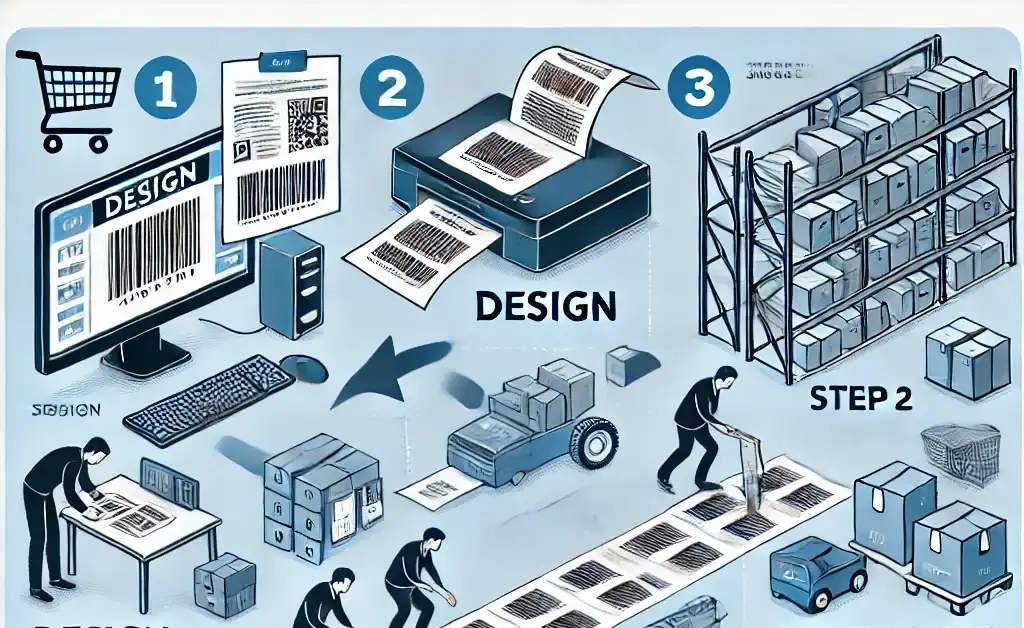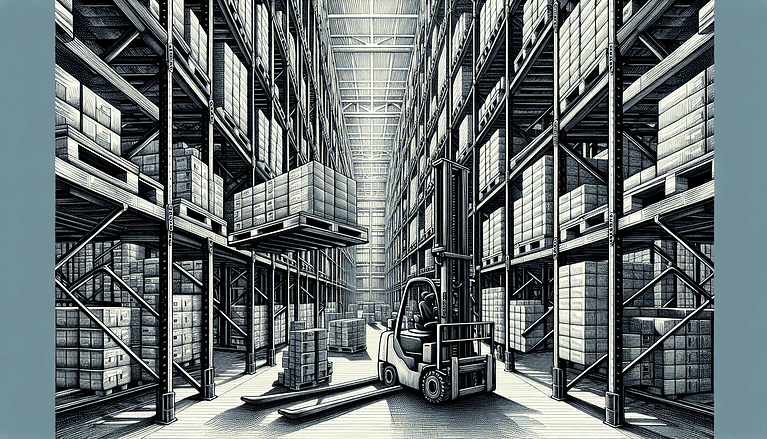Warehouse Process Standardization: Increase Efficiency by 30%
Imagine a warehouse where every operation flows like clockwork, errors are rare, and productivity soars. This isn’t a pipe dream – it’s the power of warehouse process standardization.

Table of Contents
In today’s fast-paced logistics world, warehouse process standardization isn’t just a buzzword – it’s the secret weapon of industry leaders. But what exactly is it, and why should you care?
Warehouse process standardization is the practice of establishing and implementing consistent, repeatable procedures for all warehouse operations. It’s about creating a playbook that every team member follows, from receiving to shipping and everything in between.
Why does this matter? Because in the high-stakes game of warehousing, consistency is king. Standardized processes can slash errors, boost productivity, and drive significant cost savings. Studies show that effective process standardization can increase warehouse efficiency by up to 30%.
But here’s the kicker: despite its benefits, many warehouses still struggle with inconsistent processes, leading to inefficiencies, errors, and frustrated employees. If facing these challenges, you’re leaving money on the table.
In this comprehensive guide, we’ll explore warehouse process standardization’s game-changing benefits, walk you through implementation steps, and share real-world success stories.
Whether you’re a warehouse manager looking to optimize operations or a logistics professional aiming to stay ahead of the curve, this post will equip you with the knowledge to transform your warehouse into a model of efficiency.
Ready to unlock the full potential of your warehouse? Let’s dive in.
Benefits of Warehouse Process Standardization

Implementing standardized processes in your warehouse isn’t just about ticking boxes – it’s about unlocking advantages that can transform your operations. Standardization can optimize inventory control and supply chain management, leading to more efficient and effective warehouse operations. Let’s break down the key benefits:
Increased Efficiency
When every team member follows the same optimized procedures, you eliminate wasted time and motion. Standardization reduces decision-making delays and minimizes each task’s “figuring it out” phase. The result? Faster throughput and more orders processed per hour.
Improved Quality Control
Consistency is the cornerstone of quality. Standardized processes reduce variability in how tasks are performed. This leads to fewer errors, less damage to goods, and, ultimately, happier customers. Maintaining high standards is easier when everyone works from the same playbook.
Enhanced Safety
Safety isn’t an accident – it results from consistent, well-designed processes. Standardization helps identify and eliminate potential hazards, ensuring that best safety practices are followed every time. This can lead to fewer workplace incidents and a healthier, more productive workforce.
Better Training and Onboarding
Standardized processes make training new employees a breeze. Instead of relying on tribal knowledge or inconsistent methods, you can provide clear, documented procedures for each task. This speeds up onboarding, reduces the learning curve, and ensures new hires are productive faster.
Easier Performance Measurement
When processes are standardized, measuring and comparing performance becomes much simpler. You can establish clear benchmarks and easily identify areas for improvement. This data-driven approach allows for more effective management and continuous optimization of your warehouse operations.
By embracing process standardization, you’re improving not just individual tasks but your entire warehouse operation. The cumulative effect of these benefits can lead to significant cost savings, improved customer satisfaction, and a competitive edge in the market.
Key Areas for Warehouse Operations Standardization

To maximize the benefits of standardization, it’s crucial to focus on the core processes that drive warehouse operations. Let’s examine the key areas where implementing standard procedures can yield significant improvements:
Receiving
Process: The receiving process sets the stage for all subsequent warehouse operations. Standardization here can include:
Defined procedures for unloading trucks
Consistent methods for inspecting incoming goods
Standardized documentation and data entry processes
Clear protocols for handling discrepancies or damages
An optimized warehouse layout to facilitate efficient receiving operations
Metrics: The receiving metrics ensure that the expected outcomes from the process deliver the expected results. Receiving metrics can include:
Receiving accuracy rate (aim for 99.5% or higher)
Average receiving time per truck
Dock-to-stock time
Percentage of shipments processed within 24 hours
By standardizing receiving, you ensure accuracy from the start, reducing errors that could cascade through your entire operation.
Putaway
Process: Efficient putaway is critical for optimizing space utilization and future picking efficiency. Standardized putaway processes might include:
Predefined storage locations based on product characteristics
Consistent use of barcode scanning for location tracking
Standard procedures for handling overstock or exceptions
Utilizing different putaway methods to maximize storage space
Metrics: The putaway metrics are important to ensure what was purchased and received is available for sale. Putaway metrics can include:
Putaway accuracy rate (target 99.9%)
Average putaway time per item
Inventory location accuracy (aim for 99% or higher)
Percentage of items putaway within SLA (Service Level Agreement)
A well-standardized putaway process minimizes the time goods spend in transition and maximizes storage efficiency.
Picking
Process: Picking often consumes the most labor in a warehouse, making it a prime target for standardization. Consider:
Implementing a standard picking method (e.g., wave picking, batch picking)
Establishing consistent routes for pickers
Standardizing the use of picking aids like RF scanners or pick-to-light systems
Metrics: The picking metrics to be reviewed are:
Order picking accuracy (aim for 99.9%)
Average picks per hour
Pick-to-ship cycle time
Percentage of orders picked without errors
Standardized picking processes can dramatically improve accuracy and speed, directly impacting customer satisfaction.
Packing
Process: Consistency in packing ensures that products are properly protected and orders are accurately fulfilled. Standardization here might involve:
Defined procedures for selecting appropriate packaging materials
Standard methods for order verification before sealing
Consistent labeling and documentation processes
Standardizing packing and shipping processes to improve overall warehouse efficiency
Metrics: The packing metrics should include:
Packing accuracy rate (target 99.9%)
Average packing time per order
Damage rate during packing (aim for less than 0.1%)
Packing material utilization rate
Shipping
Process: The final step in most warehouse operations, shipping standardization, ensures that products leave your facility correctly and efficiently. This could include:
Standard procedures for loading trucks
Consistent methods for generating and applying shipping labels
Standardized final quality checks before dispatch
Metrics: The recommended shipping metrics are as follows:
On-time shipping rate (aim for 99% or higher)
Order accuracy rate (target 99.9%)
Average shipping cost per order
Truck utilization rate
Returns Processing
Process: Return processing is often overlooked for customer satisfaction and inventory accuracy. Standardization here might involve:
Consistent procedures for inspecting returned items
Standard methods for determining whether items can be restocked
Defined processes for updating inventory systems
Metrics: Returns metrics include:
Returns processing cycle time
Return-to-stock rate
Percentage of returns processed within 48 hours
Cost per return processed
Focusing on these key areas creates a standardized flow throughout your warehouse. This holistic approach ensures that efficiencies gained in one area aren’t lost in another, leading to overall operational excellence.
By tracking these metrics for each standardized process, you can:
Establish baselines for current performance
Set realistic improvement targets
Monitor the impact of your standardization efforts
Identify areas that may need further optimization
Remember, while these metrics provide valuable insights, the specific targets may vary based on your industry, product type, and customer expectations. The key is consistently measuring, analyzing, and improving your standardized processes using these metrics as a guide.
Steps to Implement Process Standardization

Transforming your warehouse operations through process standardization is a journey. Here’s a step-by-step guide to help you navigate this transformation:
Analyze Current Processes
Map out existing workflows for each key area (receiving, putaway, picking, etc.).
Identify pain points, bottlenecks, and inconsistencies in warehousing operations.
Collect data on current performance metrics for each area.
Engage with staff to understand the challenges they face in daily operations.
Identify Best Practices
Research industry standards and best practices for each process.
Benchmark against top-performing warehouses in your industry.
Evaluate which practices could be adapted to your specific warehouse needs.
Consider innovative techniques that could give you a competitive edge.
Document Standard Operating Procedures (SOPs)
Draft clear, step-by-step procedures for each process.
Include visual aids like flowcharts or diagrams to enhance understanding.
Specify roles and responsibilities for each step of the process.
Define key performance indicators (KPIs) for measuring success.
Train Employees
Develop a comprehensive training program for all staff levels.
Conduct hands-on training sessions for each standardized process.
Create reference materials that employees can easily access.
Emphasize the benefits of standardization to gain buy-in from the team.
Implement and Monitor
Roll out new processes gradually, starting with pilot areas if possible.
Use technology like WMS to enforce and track adherence to new procedures.
Regularly collect feedback from employees on the new processes.
Monitor KPIs closely to measure the impact of standardization.
Continuous Improvement
Establish a system for employees to suggest improvements.
Regularly review and update SOPs based on performance data and feedback.
Stay informed about new technologies and methodologies in warehouse management.
Conduct periodic audits to ensure standards are maintained over time.
Remember, implementing process standardization is not a one-time event but an ongoing commitment to excellence. It requires patience, persistence, and a willingness to adapt as you learn what works best for your unique warehouse environment.
Tools and Technologies for Process Standardization

Implementing and maintaining standardized processes can be significantly enhanced by leveraging the right tools and technologies. Here are some key solutions that can support your warehouse standardization efforts:
Warehouse Management Software (WMS)
Core benefits:
Centralized control of warehouse operations through a warehouse management system
Real-time inventory tracking with a warehouse management system
Automated task assignment and prioritization
Standardization support:
Enforces predefined workflows
Provides data for performance analysis
Enables consistent inventory management across multiple locations
Implementation tip: Choose a scalable WMS that can integrate with your existing systems.
Barcode Scanners and RFID Technology
Key advantages:
Improved accuracy in inventory tracking
Faster data entry and retrieval
Reduced manual errors
Standardization applications:
Consistent product identification across all processes
Standardized data capture for receiving, putaway, and picking
Uniform tracking of inventory movement
Best practice: Train all staff on proper scanning techniques to ensure consistent use.
Visual Management Tools
Types of tools:
Signage and labels
Color-coding systems
Floor markings
Standardization benefits:
Clear communication of processes and expectations
Consistent identification of storage locations and zones
Standardized safety protocols and traffic management
Implementation tip: Develop a coherent visual system that’s intuitive and easy to understand.
Process Mapping Software
Key features:
Visual representation of workflows
Collaboration tools for team input
Version control for process updates
Standardization support:
Consistent documentation of processes
Easy identification of inefficiencies or redundancies
Streamlined process improvement efforts
Best practice: Regularly review and update process maps to reflect current operations.
Mobile Devices and Wearables
Applications:
Hands-free picking instructions
Real-time task updates
On-the-go data access
Standardization benefits:
Consistent information delivery to workers
Standardized task execution across the workforce
Uniform data collection methods
Implementation tip: Ensure devices are rugged enough for warehouse environments and have sufficient battery life.
Automated Guided Vehicles (AGVs) and Robotics (Material handling equipment)
Use cases:
Automated material transport
Robotic picking and packing
Autonomous inventory counts
Standardization impact:
Consistent execution of repetitive tasks
Standardized movement patterns in the warehouse
Uniform handling of products
Consideration: While powerful, these solutions require significant investment and careful integration with existing processes.
By strategically implementing these tools and technologies, you can reinforce your standardized processes, improve consistency, and drive efficiency. Remember, the goal is not to implement technology for its own sake but to support and enhance your standardized workflows.
Overcoming Challenges in Process Standardization

While the benefits of warehouse process standardization are clear, implementing and maintaining these standards can present several challenges. Here’s how to address some of the most common hurdles:
Resistance to Change
Challenge: Employees may be reluctant to adopt new processes, preferring familiar routines.
Solutions:
Communicate the benefits of standardization clearly to all staff
Involve employees in the standardization process to gain buy-in
Provide comprehensive training and support during the transition
Recognize and reward early adopters and those who excel in the new processes
Diverse Product Types or Customer Requirements
Challenge: Warehouses handling a wide range of products or serving diverse customer needs may struggle with one-size-fits-all processes.
Solutions:
Develop flexible standards that can accommodate different product categories
Create modular processes that can be adapted to specific customer requirements
Use advanced WMS features to manage varying processes for different SKUs or customers
Regularly review and update standards to ensure they remain relevant across all product lines
Standardizing processes can enhance supply chain operations by improving strategic organization and real-time inventory visibility for warehouse workers.
Balancing Standardization with Flexibility
Challenge: Over-rigid standardization can lead to inefficiencies when dealing with exceptions or unique situations.
Solutions:
Build in controlled flexibility within your standard processes
Develop clear guidelines for when and how to deviate from standard processes
Train supervisors in decision-making for non-standard situations
Regularly review exceptions to determine if standards need updating
Maintaining Standards Over Time
Challenge: Initial enthusiasm for new standards can wane, leading to gradual erosion of adherence.
Solutions:
Implement regular audits and performance reviews
Use technology to enforce and monitor adherence to standards
Provide ongoing training and refresher courses
Continuously communicate the importance and benefits of standardization
Integrate adherence to standards into employee performance evaluations
Technology Integration and Adoption
Challenge: Implementing new technologies to support standardization can be disruptive and may face resistance.
Solutions:
Choose user-friendly technologies that integrate well with existing systems
Provide thorough training on new technologies
Start with pilot programs to work out issues before full-scale implementation
Ensure IT support is readily available during and after implementation
Cost and Resource Constraints
Challenge: Standardization efforts can require significant upfront investment in time, money, and resources.
Solutions:
Prioritize areas for standardization based on potential ROI
Implement changes in phases to spread out costs and resource requirements
Look for low-cost improvements that can yield quick wins
Consider the long-term savings and efficiencies when justifying initial investments
Proactively anticipating and addressing these challenges can smooth the path to successful warehouse process standardization. Remember, the goal is continuous improvement – it’s okay to start small and scale up as you learn and adapt.
Case Studies

To illustrate the real-world impact of warehouse process standardization, let’s examine two case studies that showcase successful implementations and the lessons learned.
Case Study 1: E-commerce Giant Streamlines Operations
Company: MegaShop (pseudonym)
Industry: E-commerce retail
Challenge: Inconsistent processes across multiple fulfillment centers lead to variable performance and customer satisfaction issues.
Implementation:
MegaShop conducted a comprehensive audit of all warehouse processes across its network.
They developed standardized SOPs for each core process, from receiving to shipping.
A new WMS was implemented to enforce these standardized processes.
Extensive staff training was conducted, emphasizing the importance of adherence to new standards.
Results:
25% increase in overall warehouse productivity
Order accuracy improved from 97% to 99.8%
Customer satisfaction scores rose by 15%
Labor costs were reduced by 18% due to improved efficiency
Key Takeaway: Standardization across a warehouse network can significantly improve efficiency and customer satisfaction.
Case Study 2: Manufacturing Supplier Enhances Inventory Management
Company: PrecisionParts (pseudonym)
Industry: Automotive parts manufacturing
Challenge: High inventory holding costs and frequent stockouts due to inconsistent inventory management practices.
Implementation:
PrecisionParts standardized its inventory classification system using ABC analysis.
They implemented standardized cycle counting procedures based on item classification.
Putaway and picking processes were redesigned for consistency and efficiency.
Visual management tools were introduced to support standardized storage locations.
Results:
Inventory accuracy improved from 92% to 99.5%
Stockouts reduced by 60%
Inventory holding costs decreased by 22%
Order fulfillment speed increased by 35%
Key Takeaway: Standardized inventory management processes can significantly improve accuracy and reduce costs.
Lessons Learned from Both Cases:
Employee Involvement: Both companies emphasized the importance of involving warehouse staff in the standardization process to ensure buy-in and gather valuable insights.
Phased Implementation: Starting with pilot areas allowed for refinement of processes before full-scale rollout.
Technology as an Enabler: While process design was crucial, technology played a key role in enforcing and supporting standardized processes.
Continuous Improvement: Both companies established mechanisms for ongoing refinement of their standardized processes based on performance data and employee feedback.
Clear Communication: Regular updates on performance improvements helped maintain enthusiasm and commitment to the new standards.
These case studies demonstrate that while the path to process standardization may require significant effort, the rewards in efficiency, accuracy, and cost savings can be substantial.
They also highlight the importance of a holistic approach that combines process design, technology implementation, and employee engagement.
Measuring the Impact of Process Standardization

Measurement and quantification of improvements are crucial to ensuring the success of your warehouse process standardization efforts. This section will cover the key performance indicators (KPIs) to track and how to conduct before-and-after comparisons.
Key Performance Indicators (KPIs) to Track
- Operational Efficiency
- Order fulfillment cycle time
- Lines picked per hour
- Inventory turnover rate
- Labor hours per unit shipped
- Accuracy and Quality
- Order accuracy rate
- Inventory accuracy
- Returns due to warehouse error
- Damage rates
- Cost Metrics
- Cost per order
- Labor cost per unit
- Storage cost per unit
- Transportation cost per order
- Customer Satisfaction
- On-time shipping rate
- Perfect order percentage
- Customer complaints related to warehouse issues
- Safety and Compliance
- Workplace injury rate
- Compliance violations
- Near-miss incidents
Before and After Comparisons
- Establish Baselines
- Collect comprehensive data on all relevant KPIs before implementing standardized processes
- Ensure data collection methods are consistent and reliable
- Set Realistic Targets
- Based on industry benchmarks and your specific goals, set targets for each KPI
- Consider both short-term and long-term objectives
- Regular Measurement
- Implement a system for ongoing measurement of KPIs
- Consider using dashboards for real-time visibility into performance
- Analyze Trends
- Look beyond single data points to identify trends over time
- Pay attention to both positive improvements and areas of decline
- Conduct Periodic Reviews
- Schedule quarterly or bi-annual comprehensive reviews of all KPIs
- Compare current performance not just to the baseline but to previous review periods
- Adjust and Refine
- Use the data to identify areas where standardized processes may need refinement
- Be prepared to make data-driven adjustments to your processes
Additional Measurement Considerations
- Qualitative Feedback
- Gather input from employees on the effectiveness of standardized processes
- Conduct customer surveys to assess satisfaction with order fulfillment
- Financial Impact
- Calculate the return on investment (ROI) of your standardization efforts
- Consider both direct cost savings and indirect benefits like improved customer retention
- Benchmarking
- Compare your performance metrics to industry standards
- If possible, benchmark against competitors or similar operations
- Long-term Impact
- Some benefits of standardization may not be immediately apparent
- Track metrics over an extended period to capture long-term improvements
By diligently measuring these KPIs and conducting thorough before-and-after comparisons, you can quantify the impact of your process standardization efforts. This data not only validates the effectiveness of your initiatives but also provides valuable insights for continuous improvement.
Remember, the goal is not just to implement standardized processes but to create a culture of ongoing optimization based on measurable outcomes.
Future Trends in Warehouse Process Standardization

Measurement and quantification of improvements are crucial to ensuring the success of your process standardization efforts. This section will cover the key performance indicators (KPIs) to track and how to conduct before-and-after comparisons.
Key Performance Indicators (KPIs) to Track
Operational Efficiency
Order fulfillment cycle time
Lines picked per hour
Inventory turnover rate
Labor hours per unit shipped
- Accuracy and Quality
Order accuracy rate
Inventory accuracy
Returns due to warehouse error
Damage rates
- Cost Metrics
Cost per order
Labor cost per unit
Storage cost per unit
Transportation cost per order
- Customer Satisfaction
On-time shipping rate
Perfect order percentage
Customer complaints related to warehouse issues
- Safety and Compliance
Workplace injury rate
Compliance violations
Near-miss incidents
Warehouse Processes Before and After Comparisons
Establish Baselines
Collect comprehensive data on all relevant KPIs before implementing standardized processes
Ensure data collection methods are consistent and reliable
- Set Realistic Targets
Based on industry benchmarks and your specific goals, set targets for each KPI
Consider both short-term and long-term objectives
- Regular Measurement
Implement a system for ongoing measurement of KPIs
Consider using dashboards for real-time visibility into performance
- Analyze Trends
Look beyond single data points to identify trends over time
Pay attention to both positive improvements and areas of decline
- Conduct Periodic Reviews
Schedule quarterly or bi-annual comprehensive reviews of all KPIs
Compare current performance not just to the baseline but to previous review periods
- Adjust and Refine
Use the data to identify areas where standardized processes may need refinement
Be prepared to make data-driven adjustments to your processes
Additional Measurement Considerations
Qualitative Feedback
Gather input from employees on the effectiveness of standardized processes
Conduct customer surveys to assess satisfaction with order fulfillment
Financial Impact
Calculate the return on investment (ROI) of your standardization efforts
Consider both direct cost savings and indirect benefits like improved customer retention
Benchmarking
Compare your performance metrics to industry standards
If possible, benchmark against competitors or similar operations
Long-term Impact
Some benefits of standardization may not be immediately apparent
Track metrics over an extended period to capture long-term improvements
By diligently measuring these KPIs and conducting thorough before-and-after comparisons, you can quantify the impact of your process standardization efforts. This data not only validates the effectiveness of your initiatives but also provides valuable insights for continuous improvement.
Remember, the goal is not just to implement standardized processes but to create a culture of ongoing optimization based on measurable outcomes.
Standardization Across Multiple Facilities
Cloud-based Centralization
Cloud technologies will enable real-time synchronization of standardized processes across multiple warehouses
Central management of processes with local adaptations as needed
Digital Twins
Virtual replicas of warehouse operations will allow for testing and optimization of standardized processes without disrupting live operations
Improved ability to standardize processes across facilities with different layouts or equipment
Blockchain for Supply Chain Transparency
Standardized processes for tracking and verifying products across the entire supply chain
Improved accountability and traceability through immutable record-keeping
Sustainability-driven Process Standards
Energy-efficient Operations
Standardized processes will increasingly incorporate energy-saving measures
Integration of renewable energy sources into warehouse operations
Waste Reduction Protocols
Standardized processes for minimizing packaging waste and optimizing recycling efforts
Implementation of circular economy principles in warehouse operations
Carbon Footprint Tracking
Standardized methods for measuring and reducing carbon emissions in all warehouse processes
Integration of carbon impact into decision-making processes for routing and inventory management
Human-Robot Collaboration
Cobots (Collaborative Robots)
Standardized processes for safe and efficient human-robot interaction
Flexible automation that can adapt to changing human workflows
Augmented Reality (AR) for Process Guidance
AR glasses or devices will provide real-time visual guidance for standardized processes
Improved training and reduced error rates through AR-assisted task execution
Ergonomic Process Design
Increased focus on designing standardized processes that reduce physical strain on workers
Integration of wearable technology to monitor and improve worker health and safety
By staying aware of these trends, warehouse managers can prepare for the future of process standardization. While not all these technologies may immediately apply to every operation, understanding their potential impact can help in long-term planning and gradual implementation.
As we conclude this comprehensive guide to process standardization, remember that the key to success lies in balancing consistency with adaptability, always with an eye toward continuous improvement.
Conclusion

Warehouse process standardization is not just a buzzword – it’s a critical strategy for staying competitive in today’s fast-paced logistics landscape. As we’ve explored throughout this guide, standardization can significantly improve efficiency, accuracy, and overall operational performance.
Call to Action
Ready to take your warehouse operations to the next level through process standardization? Start by assessing your current processes and identifying areas for improvement.
If you need expert guidance, don’t hesitate to contact our warehouse optimization specialists. Together, we can transform your warehouse into a model of efficiency and excellence.





